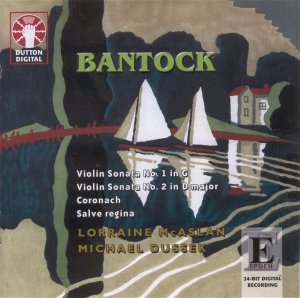Bantock's natural ‘habitat’ was the orchestra and the human
voice. The more intimate locale of chamber music seems a less obvious
constricted channel for this Big Man. Bantock did however produce a large
number of chamber works and their ranks swelled substantially during the
last three decades of his life.
These recordings are all world premiere events - a
statement that is becoming supererogatory when it comes to Dutton's
burgeoning Epoch series.
This is the third Bantock disc from this source; a
fourth (a collection of songs) will follow hot on its heels.
The present selection wondrously complements the Universal
CD released about ten years ago in which Susanne Stanzeleit recorded
the Third Violin Sonata.
The First Sonata (written for Albert Sammons)
is at first rather sternly classical but soon loosens up into a vein
of tender and sometimes visceral Tchaikovskian lyricism. This is mixed
with a sense of the fantastic derived from Schumann and, up to a point,
from Rimsky-Korsakov; a far from revolutionary work for its vintage.
The Second Sonata was written for Arthur Catterall. As you might
expect of a work post-dating the First Sonata by only three years, the
Second Sonata shares much the same character. I detected some of the
gestures of Grieg and Delius amidst the Tchaikovskian melos. Surprisingly
the central A piacere has intimations of Vaughan Williams, Bizet
(Carmen!) and even Paganini. There are several passages in the
nature of a cadenza for the solo violin. The Coronach
is a work of the war years. With its darkened viola-like tones, this
(which also exists in a version for strings, organ and harp) inhabits
regions similar to the contemplative sections of the Hebridean Symphony
and Bruch's Scottish Fantasia. The Bruch connection is not
perhaps that surprising. Bruch, after all, conducted the Liverpool orchestra
for many years while Bantock (for two seasons straddling the turn of
the century) conducted the orchestra across the Mersey from Liverpool
at New Brighton. Bruch and Bantock, rather like Schumann, also took
a shine to exotic fantasies. The Salve Regina is based
on a plainsong tune which Bantock heard at the Trappist Abbey of Our
Lady of the Lake of Two Mountains at Oka during his 1923 adjudication
tour of Canada. This has a distinctly Gregorian contour and recalls
Respighi's Concerto Gregoriano.
Satisfyingly thorough documentation from Lewis Foreman.
Unassertive, stylistically confident music played with
a rounded tenderness and with conviction.
Rob Barnett


